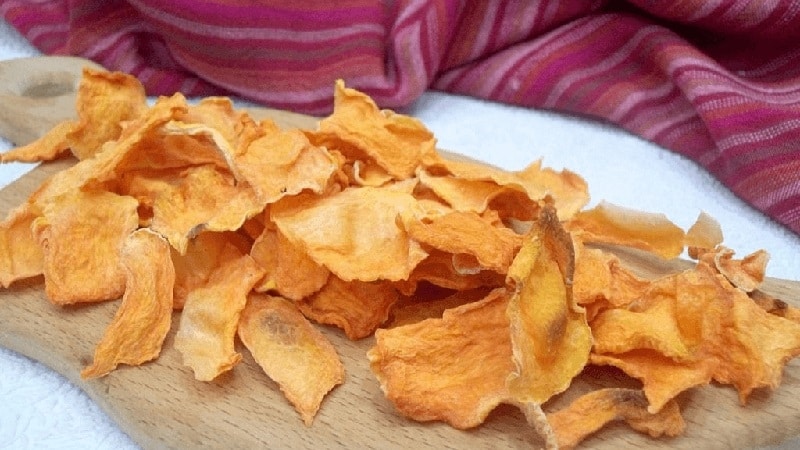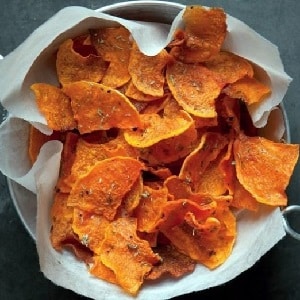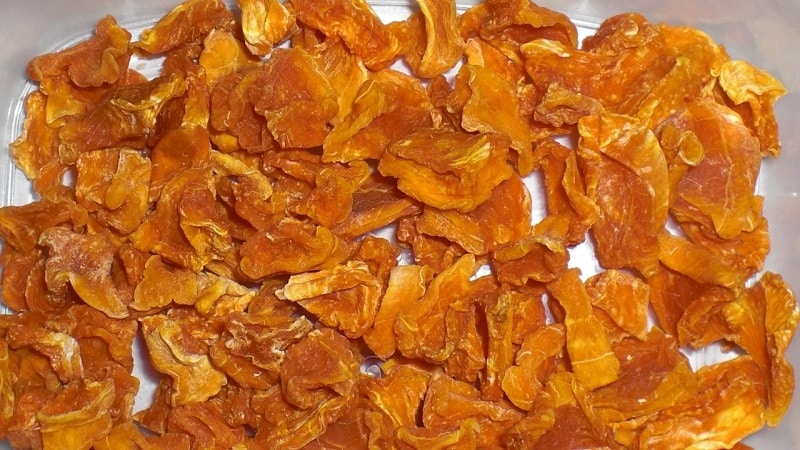Harm and benefits of dried pumpkin: how it affects the body, how to properly dry and eat it
Pumpkin is often used in children's and dietary foods. The vegetable retains its beneficial properties regardless of the cooking method. One of the options for preparing the product for the winter is drying it in the open air, in an oven or electric dryer.
Let's talk about the benefits and harms of dried pumpkin, its effect on women's male and the children's body, methods of preparation and consumption.
Dried pumpkin
Pumpkin is endowed with unique properties due to its rich chemical composition. The benefits of dried vegetables are no less than fresh. This is an ideal replacement for store-bought candied fruits with dyes and confectionery products with trans fats. Adherents of proper nutrition are happy to include the product in their diet, and children like its sweet, but not cloying taste.
Autumn thick-skinned pumpkin varieties are best suited for drying. The pulp has a bright orange taste and rich aroma.
Composition and properties
Dried pumpkin contains vitamins and microelements:
- vitamins A, C, D, E, F, PP, K, T, group B;
- pectins;
- calcium;
- cobalt;
- carotene;
- iron;
- magnesium;
- copper;
- phosphorus;
- cellulose;
- sugar.
Ascorbic acid is indispensable for immunity. Thanks to it, the body quickly copes with viral diseases. Vitamin T is not found in many vegetables, but it is present in pumpkin. It promotes the absorption of heavy foods and is useful for obese people. Vitamin T increases hemoglobin, accelerates platelet production, and improves blood clotting.
There is several times more carotene and pectin in pumpkin than in carrots. They take part in the synthesis of blood and bone proteins. Vitamin K accelerates wound healing and blood clotting.
Fiber is good for the digestive system:
- heals the intestinal flora;
- removes “bad” cholesterol and retains good cholesterol;
- promotes weight loss;
- accelerates the elimination of waste and toxins.

KBZHU
Calorie content of dried pumpkin – 68 kcal. A raw vegetable has 21 kcal.
Nutrients:
- proteins – 1.8 g;
- fats – 0 g;
- carbohydrates – 8.4 g.
The benefits and harms of dried pumpkin
Pumpkin is a storehouse of nutrients. With regular use, the body receives the necessary vitamins and microelements, the deficiency of which is acute in winter.
Benefits of dried pumpkin:
 improves memory;
improves memory;- normalizes the functioning of the gastrointestinal tract (for colitis, enteritis);
- prevents hair loss;
- rejuvenates the skin;
- improves mood;
- calms the nervous system;
- strengthens blood vessels;
- removes excess bile and mucus;
- normalizes sleep;
- strengthens the musculoskeletal system;
- accelerates bone healing during fractures;
- prevents the development of caries.
Nutritionists advise caution when introducing dried vegetables into the diet of people with acid-base imbalance and diabetes. With low acidity of gastric juice, symptoms worsen ulcers and gastritis.
Effect on the body of women, men, children
Dried pumpkin provides additional energy, increases productivity and physical activity. Nutritionists recommend including the product in the menu for athletes and people at the stage of active weight loss. The vegetable improves the condition of cancer, tuberculosis, eczema, depression, and insomnia.
Dried fruits are beneficial for women. The increased content of carotene ensures an even complexion and a beautiful tan. With regular use, hair gains volume and shine, and nails stop breaking. Antioxidants slow down the aging process, vitamins A and E smooth out fine wrinkles. During pregnancy, dried pumpkin relieves toxicosis.
The benefits of the vegetable for men's health include regulating sexual function and normalizing the functioning of the prostate gland.
Dried pumpkin is also good for children. It rarely causes allergic reactions. Fiber has a beneficial effect on the digestive system of babies, increases immunity, ensures harmonious development, normalizes sleep, and calms.
Reference. Pumpkin seeds used to remove worms.
Contraindications
It is not advisable to eat dried pumpkin if:
- acid-base balance disorders;
- diabetes mellitus;
- gastritis;
- stomach and duodenal ulcers;
- tendency to flatulence.
How to dry
Typically, an oven or electric dryer is used to prepare dried pumpkin. In summer, thinly cut slices are taken out into the open air. This is the optimal way to prepare dried pulp.
Before sending the vegetable for drying, it is recommended to immerse the prepared slices in boiling water for a few minutes. This will help maintain the rich color. To prevent spoilage of the product, the pieces are dipped in a saline solution and placed on baking sheets.

Natural drying
To sun dry a pumpkin, wash it, cut it into pieces, remove the seeds and peel off the skin. Cut the pulp into pieces and place on special trays with holes.
Cover with gauze to prevent flies from landing. After 2-3 days, turn the pieces over and leave for another 2 days. On average, the process takes up to seven days. It all depends on the weather and the number of sunny days.
There is another way of drying - over a gas stove. The slices are strung on a thick thread and hung. When the moisture has evaporated, the pieces are removed.
In the oven
The pumpkin dries much faster in the oven. The prepared vegetable is blanched in salted water, then placed on a baking sheet and placed in an oven preheated to 80-85°C for 30 minutes.
Next, the pieces are left to cool to room temperature and returned back to the oven. The drying temperature is reduced to 65-70°C. The pumpkin is kept for 30-40 minutes and the procedure is repeated again. Drying is carried out in three stages.
Advice. Keep the door slightly open to allow steam to escape freely.
In an electric dryer
This kitchen appliance allows you to quickly dry the fruit and preserve maximum beneficial properties. The slices are blanched in boiling water for several minutes, then placed on trays, and the maximum temperature is set, depending on the technical characteristics. The pumpkin is checked from time to time.
When the pieces begin to dry out, the temperature is reduced to 65°C and dried until fully cooked.
How to store
Dried vegetables are stored at a temperature not exceeding 23°C and humidity conditions not exceeding 75%. The product is placed in glass jars or paper bags. If storage conditions are met, the shelf life of dried vegetables is 2 years.
Methods and norms of use
Dried pumpkin is used to make cream soup and puree. The slices are placed in salted water and boiled until tender. Potatoes, carrots, onions and garlic. After the vegetables are cooked, beat the mixture with a blender until the consistency of puree.
The dried pieces are added as a filling to sweet and savory pies, and pumpkin powder is made from them. This is a universal product that can enrich the taste of many dishes. The powder is soaked in water or used dry as a coating for fish or meat. Flour is added to the dough and dark chocolate is prepared from it.
The daily intake of dried vegetables for adults and children is 100 g.
Conclusion
Dried pumpkin has many beneficial properties. The complex of vitamins and minerals contained in the pulp has a beneficial effect on the body of adults and children. The product is consumed in its pure form, added to cold and hot dishes.